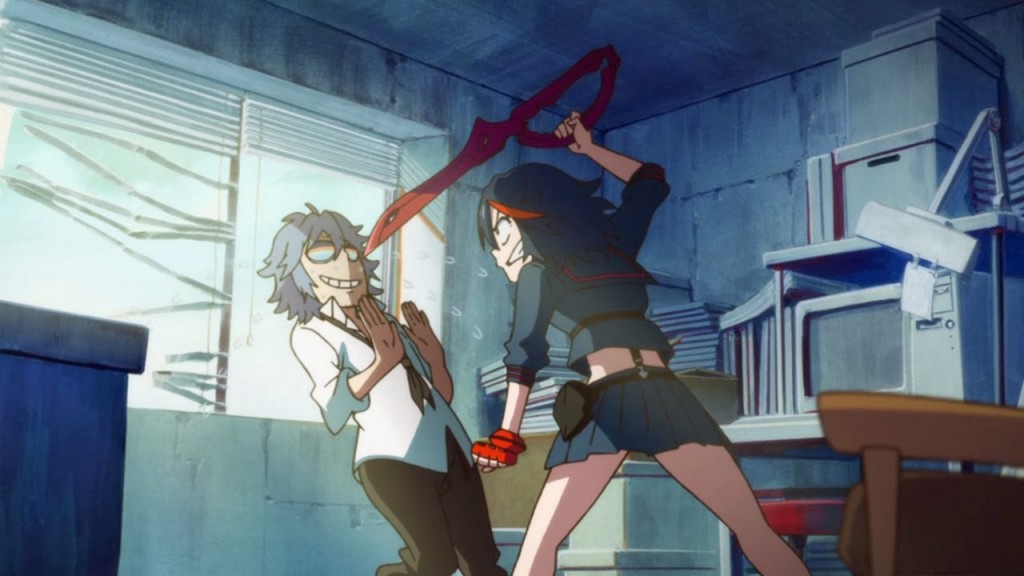 Kill la Kill, at first glance, looks like one of those shows designed for horny teen boys by a horny teen boy. Nearly naked women battle each other for the pleasure of male onlookers.
Kill la Kill, at first glance, looks like one of those shows designed for horny teen boys by a horny teen boy. Nearly naked women battle each other for the pleasure of male onlookers.
Only Kill la Kill has far more to it than that.
I will be honest. At first watch, this anime made me uncomfortable. I dislike fan service. It is immature and detracts from the story. Fan service can be defined as sexually suggestive scenes or character designs that do not contribute to the plot and exist only to sexually excite the audience.
Kill la Kill takes fan service head on and shows how ridiculous it is.
I already wrote and article about how Kill la Kill satirizes our relationship with clothing and fashion. Like my previous article, this one will have spoilers.
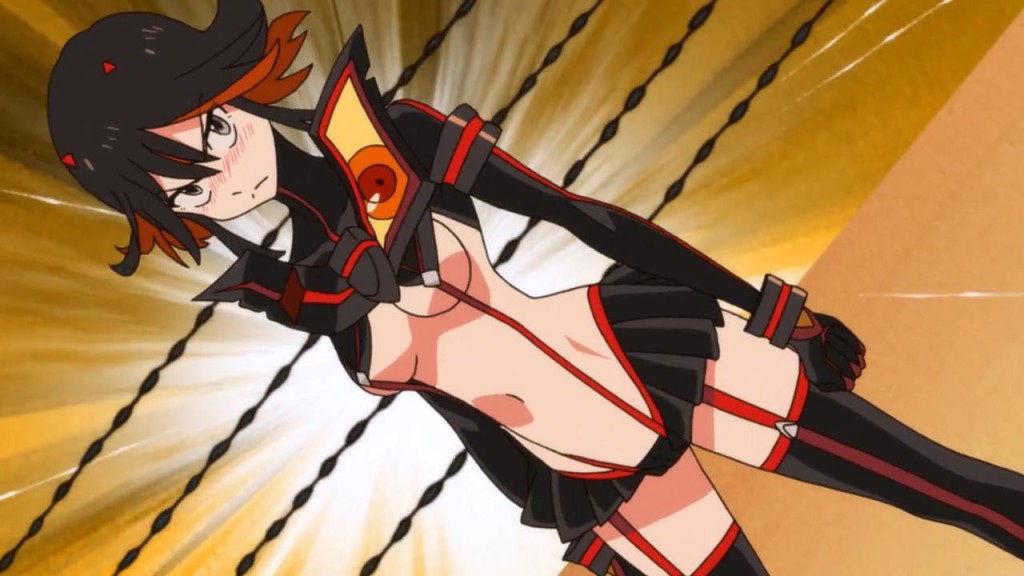 Kill la Kill opens with Ryuko Matoi looking for her father’s killer. Unlike many “magical-girl” anime, Ryuko is out for herself. She has a goal. She has the will. Her sailor uniform, Senketsu, is the means, but as the story progresses, you learn Senketsu believes Ryuko didn’t need him either. Ryuko is a strong female lead from her first scene. She has steel determination and doesn’t need a man to help her, unlike other strong female characters. Bleach’s Rukia, for example, is a strong character, but she ultimately becomes a damsel for Ichigo to save. Many stories take strong female characters and make them palatable by turning them into the “princess in the castle.” Ryuko tears that castle down.
Kill la Kill opens with Ryuko Matoi looking for her father’s killer. Unlike many “magical-girl” anime, Ryuko is out for herself. She has a goal. She has the will. Her sailor uniform, Senketsu, is the means, but as the story progresses, you learn Senketsu believes Ryuko didn’t need him either. Ryuko is a strong female lead from her first scene. She has steel determination and doesn’t need a man to help her, unlike other strong female characters. Bleach’s Rukia, for example, is a strong character, but she ultimately becomes a damsel for Ichigo to save. Many stories take strong female characters and make them palatable by turning them into the “princess in the castle.” Ryuko tears that castle down.
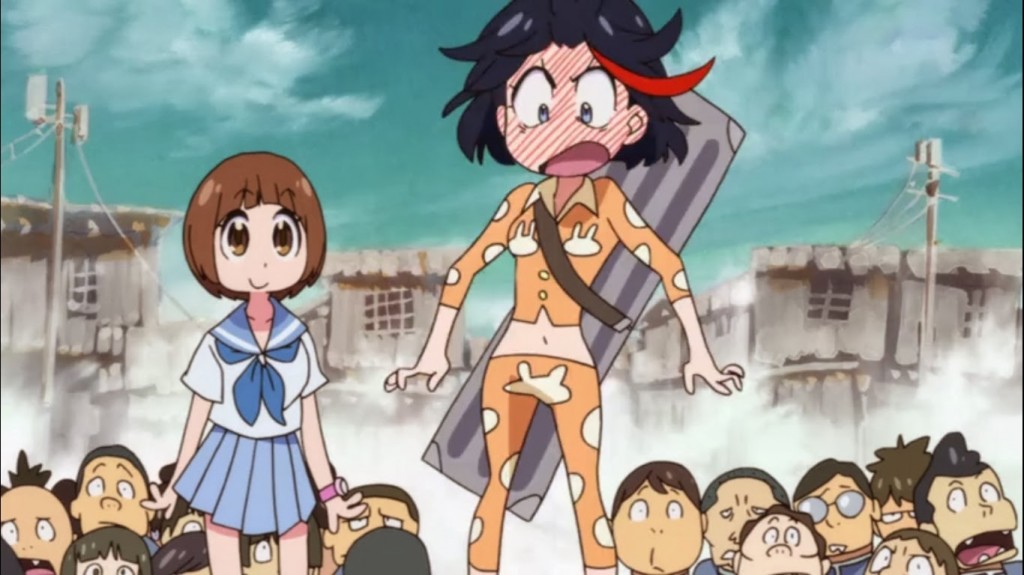 So what of her battle-attire? Fan service is another method to allow males to visually “own” strong female characters. Ryuko’s nearly nude armor certainly seems this way. When she first fights wearing Senketsu, she enters the scene wearing a cloak to hide her nudity and, by extension, her fear of public ridicule. When people see her tiny outfit, she is quite naturally embarrassed. The first several episodes are spent “slut shaming” her. This is actually a plot point for Ryuko’s character. She spends her attention trying to cover her femininity. This can be considered a metaphor for how women are taught to be sexy, but not too much so. As if the female body is only something that can be possessed and otherwise something to feel ashamed of having. Ryuko only becomes a better fighter when she learns not to care about the misguided opinions of others. She embraces her femininity as a weapon and as a part of herself.
So what of her battle-attire? Fan service is another method to allow males to visually “own” strong female characters. Ryuko’s nearly nude armor certainly seems this way. When she first fights wearing Senketsu, she enters the scene wearing a cloak to hide her nudity and, by extension, her fear of public ridicule. When people see her tiny outfit, she is quite naturally embarrassed. The first several episodes are spent “slut shaming” her. This is actually a plot point for Ryuko’s character. She spends her attention trying to cover her femininity. This can be considered a metaphor for how women are taught to be sexy, but not too much so. As if the female body is only something that can be possessed and otherwise something to feel ashamed of having. Ryuko only becomes a better fighter when she learns not to care about the misguided opinions of others. She embraces her femininity as a weapon and as a part of herself.
Slut shaming is when a girl is shamed for not meeting certain cultural female norms, such wearing certain clothing or behaving in ways that do not meet societal expectations. “Sluts” are often girls who go their own way. Ryuko falls into this category. She is a “slut” because she is strong willed and wears the skimpy Senketsu. Never mind the person she actually is: caring for her friends, strong willed, determined, and driven. By embracing and ultimately disregarding the “slut” label the early fan service imposes on her can she become fully herself.
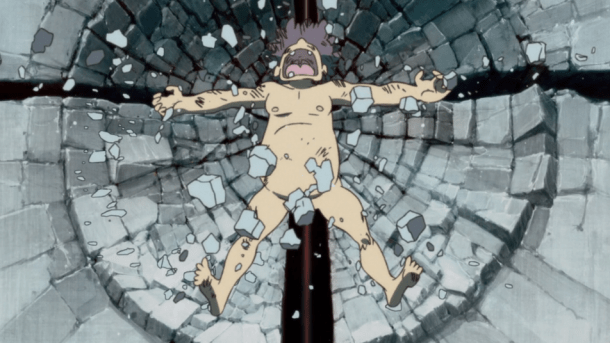
Kill la Kill also treats guys in the same way as girls. Although there are more female characters. The first instance of fan service is a fat guy. As the story progresses, male nudity becomes increasingly common. In the late half of the series, clothing becomes an object of fan service. Everyone except for Ryuko and her nemesis Satsuki Kiryuin are naked. Nudity loses its value as a titillating factor. Kill la Kill gradually desensitizes the audience to nudity. Eventually, Ryuko’s skimpy outfit simply becomes an outfit. I stopped seeing the outfit and saw Ryuko’s character as the story progressed.
Is Kill la Kill feminist?
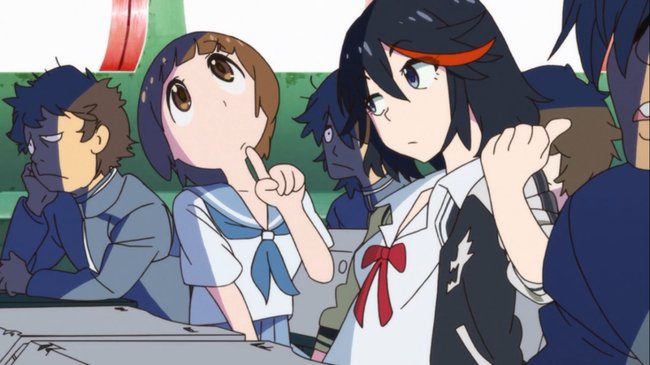 I often feel hesitant when it comes to feminism. It is not because I am against the ideas of feminism. I am not. Rather, it is because I am a guy who is looking in. I cannot understand the struggles women feel about their sexuality, and how that sexuality is exploited. I cannot understand what it is like to be objectified because of certain body parts. Although I can understand some of the resentment. I dislike being lumped in with the idea of sex-driven masculinity. Guys are more than their sex drive, just as women are more than their boobs.
I often feel hesitant when it comes to feminism. It is not because I am against the ideas of feminism. I am not. Rather, it is because I am a guy who is looking in. I cannot understand the struggles women feel about their sexuality, and how that sexuality is exploited. I cannot understand what it is like to be objectified because of certain body parts. Although I can understand some of the resentment. I dislike being lumped in with the idea of sex-driven masculinity. Guys are more than their sex drive, just as women are more than their boobs.
Anyway, I will give a clear answer: Yes. Kill la Kill is a feminist anime.
First, Ryuko and Satsuki are not fighting over a guy. Fighting over a male is a tired storyline and a male fantasy. Rather, their disagreement is over withheld information and a clash of personalities.
Second, you don’t see any of the main female characters being held as a reward for a male hero.
Third. Ryuko is a strong female lead that does not need a male to rescue or otherwise help her. Although you can argue Senketsu is a male help-mate, he is still clothing. He augments the strength Ryuko already posses.
Fourth. The entire point of the skimpy outfits is to force Ryuko to embrace herself completely. Satsuki Kiryuin sums this idea:
This is the form in which a Kamui is able to unleash the most power! The fact that you are embarrassed by the value of the masses only prove how small you are! If it means fulfilling her ambitions, Satsuki Kiryūin will show neither shame nor hesitation, even if she bares her breasts for all the world to see! My action are utterly pure!
Only by embracing her body and disregarding what others think of it can Ryuko unlock her full power. Holding onto societal views toward the female body holds Ryuko back. She is ashamed of herself. This shame keeps her from reaching her full potential.
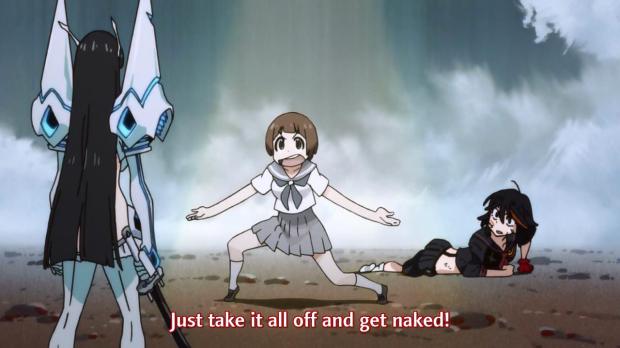 Nudity does not always mean titillation. Kill la Kill satirizes fan service and sexuality in media. Magazine covers often feature women dressed in less than Ryuko. Kill la Kill is telling us that clothing or lack thereof has little bearing on who a person is. Ryuko is who she is regardless of the clothing she wears or doesn’t wear. The series points to how ridiculous it is to base assumptions on dress. So what if a woman wears little? A guy can run around without wearing a shirt and no one says anything. He is not judged as a man that sleeps around or as less of a person. If a women would do such, police would descend on her. Nudity is nudity regardless of gender. Either both should be shrugged off, or the same standards be enforced. Clothing is used as a barometer about a person’s character. I am guilty of this. Kill la Kill decided to shrug nudity off. The end of the series points to how clothing cannot be used as a character barometer, especially when the birthday suit is the suit of choice!
Nudity does not always mean titillation. Kill la Kill satirizes fan service and sexuality in media. Magazine covers often feature women dressed in less than Ryuko. Kill la Kill is telling us that clothing or lack thereof has little bearing on who a person is. Ryuko is who she is regardless of the clothing she wears or doesn’t wear. The series points to how ridiculous it is to base assumptions on dress. So what if a woman wears little? A guy can run around without wearing a shirt and no one says anything. He is not judged as a man that sleeps around or as less of a person. If a women would do such, police would descend on her. Nudity is nudity regardless of gender. Either both should be shrugged off, or the same standards be enforced. Clothing is used as a barometer about a person’s character. I am guilty of this. Kill la Kill decided to shrug nudity off. The end of the series points to how clothing cannot be used as a character barometer, especially when the birthday suit is the suit of choice!
People who consider Kill la Kill anti-women because of all the nudity are actually slut shaming. Could Kill la Kill work without the skimpy outfits. No. Not really. It would lose most of its message and encourage the continuation of female sexual exploitation rather than satirize it and demand the audience to move beyond societal labels. Demanding strong female characters, or women in general for that matter, to always cover up is a form of slut shaming. It sends a message that the female body is something shameful that needs to be covered. It points to how strong females cannot be strong females if she bares skin. She becomes a slut.
 It takes a heck of a lot of self confidence to wear revealing clothing. It takes a heck of a lot more for a girl to wear revealing clothing and risk being slut-shamed. The problem isn’t with the girl. The problem is with the mentality of the onlookers. A guy should never look at a girl, no matter what she is wearing, and think about how he would like to “do” her. The fault is not with the girl. The fault is with the guy. So too with the people who view Ryuko as a sex object because of her clothing instead of a strong female protagonist. Kill la Kill does everything it can to point at how it is the viewer who has the problem and not the person wearing the clothing.
It takes a heck of a lot of self confidence to wear revealing clothing. It takes a heck of a lot more for a girl to wear revealing clothing and risk being slut-shamed. The problem isn’t with the girl. The problem is with the mentality of the onlookers. A guy should never look at a girl, no matter what she is wearing, and think about how he would like to “do” her. The fault is not with the girl. The fault is with the guy. So too with the people who view Ryuko as a sex object because of her clothing instead of a strong female protagonist. Kill la Kill does everything it can to point at how it is the viewer who has the problem and not the person wearing the clothing.
Gender ideas are ingrained to the point of being subconscious. Sometimes it takes a story as crazy as Kill la Kill to rub our face into ideas we cannot otherwise see. Kill la Kill uses fan service to satirize fan service. The story’s strong female characters embrace their femininity and stop caring about the opinions of onlookers. Ryuko comes to understand that others’ opinions have no bearing on who she is. That, if nothing else, is an idea women and men need to learn.
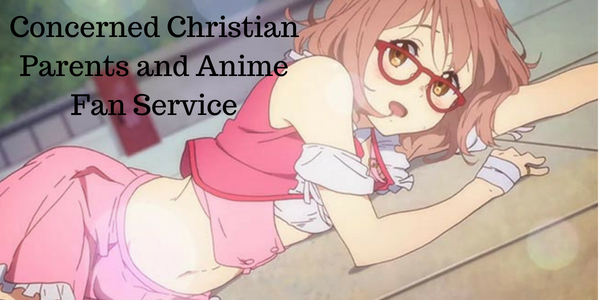
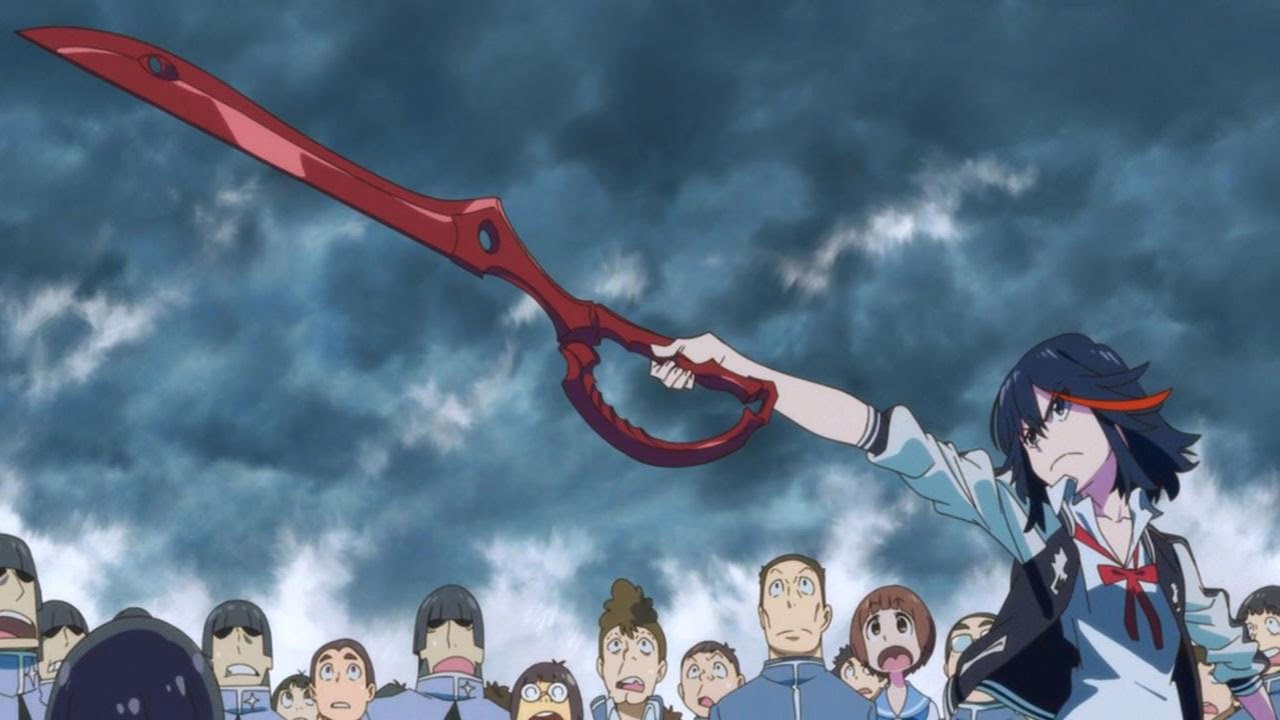
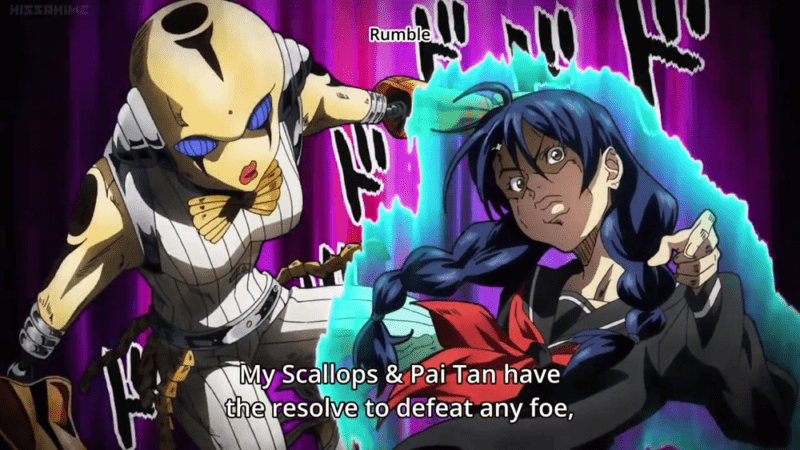

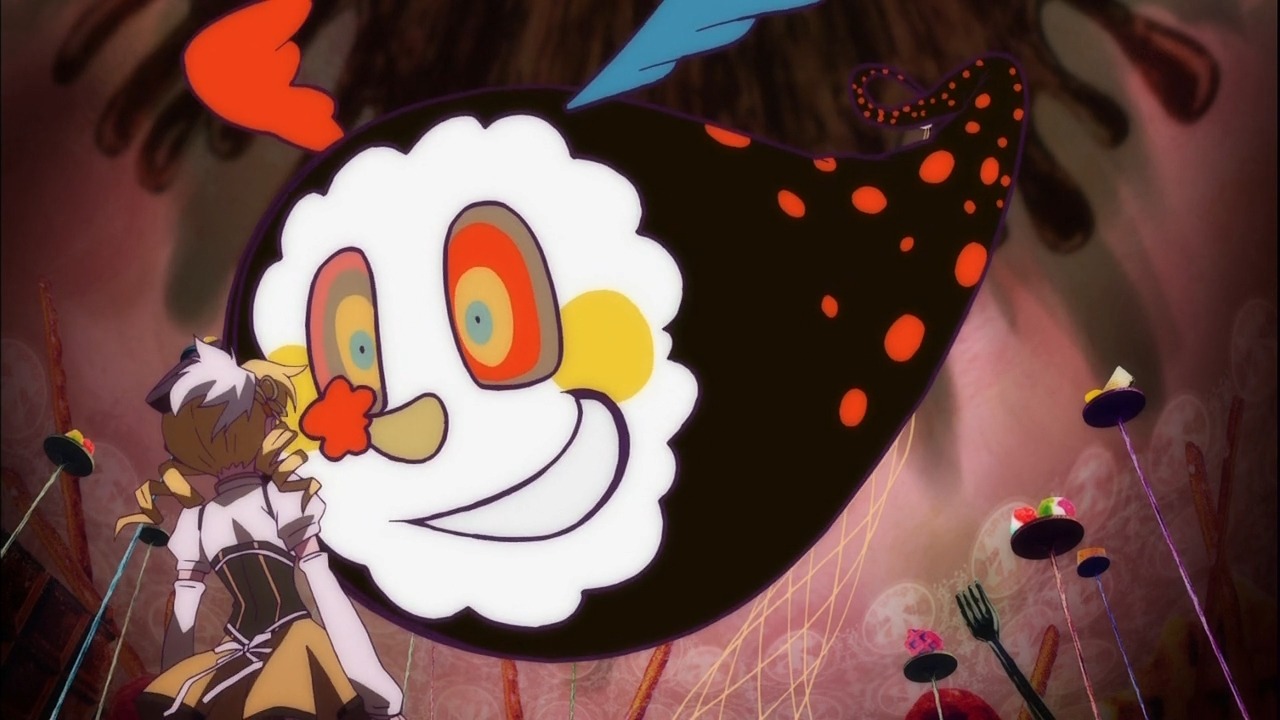

As expected of anything that involves “feminism”. This is, without doubt, trash.
“They don’t fight over a guy”? The only reason why Ryouko starts the madness is because of her dead dad.
Trash, trash, trash. Go get your facts right.
Thank you.
Having her dad act as a catalyst for the story is different from fighting over a guy’s attention. What other facts do you see as incorrect?
Damn this is one dumb piece of writing
Why do you think it is a dumb piece of writing?
Thank you for your review on this anime and in particular this topic. You have persuaded me to watch Kill la Kill.
However I also have another question to ask would I be able to use your Site as a reference for my extend project qualification (EPQ)?
If so thank you very much.
If not thank you anyway.
P.S. You can just call me Asce
Hello Asce,
Sorry about the problem you had with commenting. Every so often the comment box doesn’t like to work immediately. I’m not sure why. Kill la Kill isn’t for everyone, but it has some nice animation and a style of its own that I found refreshing. Too many anime rely solely on the usual copy-cat drawing style we consider to be anime now.
Yes, you can cite me for your project. My goal for JP was to provide some decent, research based articles for people to use. I’m pleased that you found an article that can help you : ).
I haven’t finished the series yet but I’m just playing the devil’s advocate and adding some more points for further analysis:
1. I think the show definitely tackles some feminist issues here, but I wonder if it’s truly feminist when Ryuko misses her horny voyeurs (the father, the younger brother of Mako and their male dog who always get punished by Ryuko) in the episode when the Mankanshoku family gets to live as upper class (?) I found it very disturbing for Ryuko to long for her voyeurs as if she waits for them to show up from the window when she’s fully naked in the shower room.
2. If you watched enough ‘magical girl genre’ (such as Sailor Moon, Puella Magi, Pretty Cure or even Layearth with a solid history of over 50 years in Japan) this show also serves as a critique (or even parody/satire) of girls fighting in skimpy and impractical clothes. If you think about any of the girl fighters from the shows mentioned above, none of them ever questioned the practicality of their battle suits nor do they seem to have any issues about revealing their legs when they fight… In this sense, when Kamui tells Ryuko not to be ashamed of her clothes or nudity to unleash Kamui’s full power, I took it as ‘you gotta feel “natural” and even be unconscious about your skimpy/impractical clothes and nudity (for fan service) like any other magical girl in the past so you can be as powerful as them!’ I couldn’t stop laughing XD Are there any male characters in the show who complain about the ‘impracticality’ or ‘revealingness’ of their uniforms and are there any female characters stronger than the two heroines with more clothes than them? (Nui doesn’t count as real woman…) If not, it’s because the more fan service (more nudity) a character SACRIFICES TO KAMUI (magical power) the more power he/she obtains. This kind of nudity is different from the kind of nudity revealed by the teacher from Nudist Beach. The teacher strips narcissistically (even to a point of forcing Ryuko to watch him) for his pleasure and this is not the case for our heroines.
3. My third point could be wrong since I don’t know what happens in the end. I’m guessing that Satsuki’s mother is the ultimate villain of the show and if so, I wish the villain is an old pervey man to make it more ‘feminist’ (like a battle against patriarchy). Many and most? ‘final boss’ in magical girl genre are adult female who are selfish, materialistic, full of jealousy (for not able to get their man) and sexually-liberated with great power. They are basically the opposite of a ‘good mother’. If this is the case for this show, we get the cliche of girls vs powerful adult female who are powerful/ successful in society but failed to be caring mothers…. It’s like hinting that girls can’t fight against male final boss so let’s have a weaker female one. It’s nice that Satsuki’s mother is a successful CEO though, and yet it makes me think that she’s powerful because she’s willing to show her bweeeeeebs if my second point makes sense above.
4 (just for fun as a side note). In Japan fetishism for uniforms runs deep especially for girl’s sailor uniform. Sailor uniform is like a symbol of pubescent girls…. It is true that the Japanese government adopted military soldier’s uniform for male students and navy’s uniform for female students in early 20th century. The gov probably did it to to celebrate militarism because Japan wanted to prove to the West that Japan’s a ‘powerful’ ‘advanced’ country. I don’t know how true this is, but I heard male student’s uniform (called gakuran in Japanese) was based on the uniform of higher-ranking military officers while female student’s uniform was that of lower ranked sailors, so there could be some inherent sexism
Sorry for the typos! When I said Kamui I meant Senketsu.
FORGOT TO MENTION A SUPER IMPORTANT POINT…
The most disturbing part of this anime in terms of feminism is the reflection and critique of these magical battle suits (whether that’s in Pretty Cure, Sailor Moon etc) as a product of male’s erotic desire… Satsuki and Ryoko’s father is the scientist responsible for the slutty design! He even told 5 year-old Satsuki that Junketsu is your wedding dress! (Does it ring a bell that another magical girl show called Wedding Peach has wedding dress as battle suit?!) It’s almost like the father is indirectly sexually harassing his daughters through the power/clothes he gave them = =
Kill la Kill does a good job of calling attention to this problem. While the magical girl genre targeted girls, many guys entered the picture and made the genre erotic.
You make very good points. Let me respond to them in turn.
1. The voyeur scene seems odd for a feminist story. At least at first. The point of this scene deals with how Ryuko would rather deal with relatively harmless voyeurism compared to the corrosive and ultimately destructive materialism that the family embraced. Their voyeurism didn’t objectify her as much as the family using her as a bank for their material gains. They were using her worse than with their gawking.
2. Excellent points on how Kill la Kill critiques the magical girl genre. The satire that suffuses the series is sometimes lost on viewers, particularly male viewers who are not family with the magical girl genre.
3. Satsuki’s mother acting as the villain points out how women our their own worst enemies. If you listen carefully to mother’s dialogue, she spouts many of the arguments women use against others. She even slut shames Satsuki and Ryuko despite being worse in many regards. Kill la Kill avoid the challenge to patriarchy in favor of addressing how many women perpetuate the patriarchal system.
4. I wrote an article about the development of school uniforms. Guys wore Army uniforms while girls wore Navy. Both were of equal military rank.
Excellent comment!
How come noone’s left a comment here yet? D: I just finished Kill la Kill and it was amazing. At first I didn’t want to watch it exactly because of the pure fanservice and Ryuko’s uniform but oh am I so glad I still watched it. I consider myself as a feminist(the generic type, not the type who despites anyone due to their gender) and this series reassured my feeling in many ways. I loved how they had eye-candy for both genders and it still didn’t turn out to be the main thing in it, it clearly completed the plot. I could see the “bad feminist” in Kiryuin Ragyo, because she brainwashed men and only women were her real companions. On the other hand was the Ryuko&Satsuki team who didn’t give a single shit about gender, cared for each other equally and picked fight with each other equally. Well, at least in the last episodes.
I’m still under a huge shock by this series. I’m glad, you don’t have the wrong idea about feminism and have views like this. Your review was pretty good despite, although there were some grammatical issues. Keep it up and thank you ^^
I was also hesitant to watch Kill la Kill because of the fanservice, but I quickly realized it was meant to be satirical. Ryuko is a great female protagonist. It is the type of story that lingers after it is finished. The best stories make you reconsider your views on a topic.
I’m glad you enjoyed it. No matter how many proofreading passes I make, there is always some bit of grammar that escapes me. I aim for good enough rather than perfect. : )